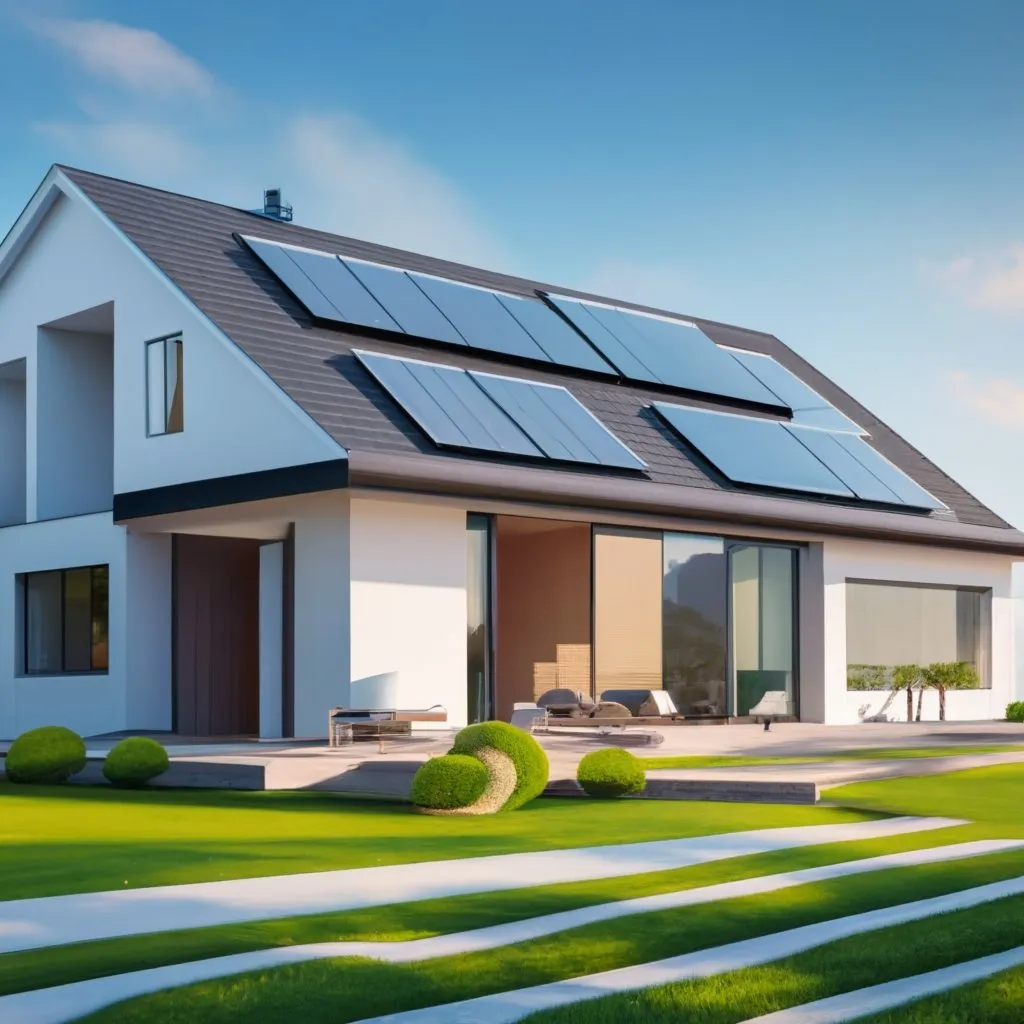Introduction
In the current era, where sustainability and innovation go hand in hand, solar energy has gained an increasingly significant space. It represents one of the cleanest and most abundant energy sources available, using sunlight to generate electricity and power countless homes, businesses and industries around the world.
Solar energy has emerged as a viable and eco-efficient alternative, contributing not only to the reduction of greenhouse gas emissions, but also enabling significant financial savings in the long term. Currently, its importance is widely recognized, and its adoption has been encouraged by various public policies, awareness projects and financial incentives.
Within this context, this article's main objective is to unveil the process of installing solar energy. We seek to demystify each step, providing a practical and informative guide for all those who wish to adopt this form of renewable energy. Throughout the text, we will explore the basic components of the solar system, the steps for installation, and answer frequently asked questions, so that you are fully prepared to embark on this sustainable journey.
So, if you are considering becoming part of the green revolution and want to understand more about installing solar energy, read on. Let's go together, step by step, unraveling each aspect of this transformative process and lighting the path to a cleaner and more sustainable future.
Benefits of Solar Energy
Sustainability and Environmental Impact
One of the main attractions of solar energy is, without a doubt, its sustainable nature. By directly converting sunlight into electricity, this form of energy eliminates the need for fossil fuels, significantly reducing greenhouse gas emissions. Furthermore, solar energy contributes to reducing dependence on non-renewable energy sources, promoting the conservation of natural resources and the preservation of biodiversity.
The positive environmental impact of solar energy is immense. Its large-scale adoption can help combat climate change, improve air quality and reduce the carbon footprint of individuals and companies. This is an investment not only in the economy, but, above all, in the future of our planet.
Long-Term Cost Reduction
Installing a solar energy system initially represents a significant investment. However, the long-term financial benefits are considerable. Once installed, the solar system begins to generate free energy, enabling a substantial reduction in your electricity bill.
Furthermore, several countries and regions offer tax incentives, discounts and financing for installing solar energy, making the initial investment more accessible. Over time, the system pays for itself and begins to generate savings, which, combined with the long useful life of the solar panels, results in years of practically free energy.
Energy Independence
Solar energy provides users with remarkable energy independence. By generating your own electricity, you are not at the mercy of price fluctuations and supply interruptions that can affect conventional power grids. This is especially valuable in remote regions or regions with unstable power supplies.
In addition to security and reliability, energy independence allows for greater autonomy and self-sufficiency, contributing to the empowerment of communities and individuals. As we move towards a more sustainable future, the ability to generate and control our own energy will become increasingly valuable.
When considering the adoption of solar energy, it is essential to consider these benefits. Sustainability, long-term cost reduction and energy independence are significant advantages that make solar energy an attractive and responsible option for the present and the future.
Understanding the Basic Components
Before embarking on the journey of installing solar energy, it is essential to understand the basic components that make up a photovoltaic system. Let's explore solar panels, inverters, and batteries to understand their functions, available types, and how to make the right choices.
Solar panels
Types of Solar Panels
There are several types of solar panels on the market, each with its own characteristics and advantages. The most common are monocrystalline, polycrystalline and thin-film solar panels. Monocrystalline panels are known for their high efficiency and elegant design, while polycrystalline panels are more affordable and versatile. Thin film panels are light and flexible, making them an interesting option for irregular surfaces.
How They Work
Solar panels work by capturing sunlight and converting it into electricity. They are made up of solar cells, which contain semiconductor materials such as silicon. When sunlight hits these cells, it causes electrons to move, generating an electrical current that can be used to power appliances and lighting.
Inverters
Function of Inverters
Inverters play a crucial role in any solar power system. They are responsible for converting the direct current (DC) generated by solar panels into alternating current (AC), which is the type of electricity used in homes and businesses. Without an inverter, the energy generated by solar panels could not be used to power most electrical appliances.
Types of Inverters
There are several types of inverters available, including string inverters, microinverters, and hybrid inverters. String inverters are common in large-scale installations, while microinverters are generally used in smaller systems and offer greater efficiency. Hybrid inverters, in turn, can be used in grid-connected or isolated systems, providing more flexibility.
Batteries
The Importance of Batteries
Batteries are an essential component for standalone or hybrid solar power systems, allowing energy to be stored for use when the sun is not shining. They ensure that the system is able to supply electricity continuously, even at night, on cloudy days or in periods of high demand.
How to Choose the Right Battery
Choosing the right battery depends on several factors, such as the required storage capacity, available budget and personal preferences. There are different types of batteries, such as lithium-ion, lead-acid and nickel-cadmium, each with its advantages and disadvantages. When choosing a battery, it is important to consider lifespan, cost, efficiency and ease of maintenance.
By understanding the basic components of a solar energy system, you will be better prepared to make informed decisions and optimize your system's performance. Each component has a vital role to play, and choosing the right products can make all the difference in your solar energy experience.
Basic Installation Steps
Site Assessment
Solar Incidence Analysis
The first step in installing a solar energy system is to analyze the solar incidence in the area. This involves evaluating the amount of sunlight that the location receives during the day and throughout the year, which will directly influence the system's performance.
System Sizing
After analyzing the solar incidence, it is essential to properly size the system. This means determining how much energy you need to generate, which in turn will influence the number and type of solar panels, inverters and batteries you need.
Financial planning
Costs Involved
Understanding all the costs involved is essential for solid financial planning. This includes the cost of equipment, installation, maintenance and possible fees or licenses.
Tax Incentives and Financing
Investigate the tax incentives, subsidies and financing options available in your area. These incentives can significantly reduce the initial cost and improve the return on investment.
Choice of Equipment
How to Choose the Right Components
Choosing the right components is crucial to optimizing system performance. Consider efficiency, durability, warranty and compatibility when choosing solar panels, inverters and batteries.
Brand and Model Recommendations
Research and consult professionals in the field to obtain recommendations for reliable, cost-effective brands and models. Choosing quality equipment can result in greater efficiency and less need for maintenance.
System Installation
Installation Process
The installation process must be carried out by qualified professionals to ensure the safety and effectiveness of the system. It includes assembling the panels, installing the inverters, connecting the batteries and integrating with the existing electrical grid.
Hiring Qualified Professionals
Hiring qualified professionals is essential. Make sure the team has proven experience, good references and up-to-date knowledge of best practices and local regulations.
Maintenance and Monitoring
Post-Installation Care
After installation, it is important to carry out regular maintenance of the system to ensure its proper functioning. This includes cleaning panels, checking connections and inspecting equipment.
How to Monitor System Performance
Continuous monitoring of system performance allows you to identify and correct any problems quickly. Many systems come with apps or online platforms that make it easy to monitor solar energy yield.
By following these basic steps for installing solar energy, you will be on your way to taking advantage of a clean, renewable and economical energy source, contributing to a more sustainable future.
Practical Tips and Recommendations
Tips for Maximizing System Efficiency
1. Correct Positioning of Panels:
- Solar panels should be installed in locations that receive direct sunlight for most of the day, preferably facing north in the southern hemisphere.
Regular Monitoring:
- Monitoring system performance regularly can help identify and resolve issues quickly, ensuring maximum energy production.
3. Panel Maintenance:
- Regularly cleaning your solar panels is essential to prevent the build-up of dirt or debris that could block sunlight and reduce efficiency.
4. Use of Advanced Technology:
- Investing in technologies such as microinverters and power optimizers can significantly increase the efficiency of the solar system.
Use and Maintenance Recommendations
1. Periodic Inspections:
- Carrying out periodic inspections to check the condition of panels, cables and connections can prevent failures and extend the system's useful life.
2. Battery Maintenance:
- If the solar system includes batteries, it is essential to ensure they are properly maintained, following the manufacturer's recommendations.
3. Software Updates:
- Keeping the system's monitoring and control software always up to date ensures that improvements and bug fixes are taken advantage of.
Strategies to Optimize Return on Investment
1. Tax Incentives and Subsidies:
- Exploring tax incentives, subsidies and financing programs can significantly reduce the initial cost and improve your return on investment.
2. Sale of Surplus Energy:
- Checking the possibility of selling surplus energy to the local electricity grid can generate additional revenue and accelerate the return on investment.
3. Smart Consumption:
- Adapting energy consumption patterns, using more energy during the day, can help maximize the use of solar energy produced.
4. Price Research and Comparison:
- Before purchasing the system, it is essential to research and compare prices from different suppliers and installers to ensure the best value for money.
By following these practical tips and recommendations, users of solar energy systems can maximize efficiency, extend service life and optimize return on investment, making the most of the benefits of this renewable energy source.
Debunking Common Myths
As solar energy becomes increasingly popular, it is natural for various, often conflicting, information to emerge about this technology. Let's uncover some of the most common myths related to the cost, efficiency and maintenance of solar photovoltaic systems.
Myths about Cost
“Solar Energy is Very Expensive”
One of the most persistent myths is that solar energy is inaccessible and expensive. However, the costs of solar systems have been steadily decreasing over the years. Furthermore, tax incentives, financing and savings on electricity bills make investment increasingly attractive and accessible.
“Return on Investment Takes a Long Time”
Many people believe that it will take decades to recoup their initial investment. However, with reduced dependence on grid power and available incentives, the payback period has become increasingly shorter, often between 5 and 10 years, depending on the location and size of the system.
Myths about Efficiency
“Solar Panels Don’t Work on Cloudy or Rainy Days”
There is a misconception that solar panels only generate energy on sunny days. In fact, even on cloudy or rainy days, solar panels continue to produce electricity, albeit in a reduced quantity, ensuring a continuous supply of energy.
“Solar Energy Is Not Viable in Cold Locations”
The cold climate, in itself, does not prevent the generation of solar energy. In fact, solar panels tend to work more efficiently at lower temperatures. The important thing is the incidence of sunlight, making solar energy a viable option even in regions with harsh winters.
Myths about Maintenance
“Solar Systems Require Constant Maintenance”
The belief that solar systems require constant and costly maintenance is a myth. In reality, solar systems are designed to be durable and require relatively little maintenance. Periodic cleanings and annual inspections are generally sufficient to keep the system operating efficiently.
“The Lifespan of Solar Panels is Short”
Some believe that solar panels have a short lifespan and will need to be replaced frequently. However, most modern solar panels come with 25- to 30-year warranties and can continue to work efficiently well beyond that period.
By clarifying these common myths, we can better understand the real benefits and limitations of solar energy and make more informed decisions. Solar energy is an increasingly viable and beneficial option, both for the environment and for the domestic economy.
Barriers and Solutions
Common Installation Challenges
Installing a solar energy system can present several challenges, one of which is the suitability of the location. Not all roofs are ideal for solar panels due to their orientation, slope or structure. Furthermore, the occurrence of shadows can significantly impact system efficiency. Another common challenge is obtaining permits and adhering to local regulations, which can vary significantly from one region to another.
Practical Solutions and Alternatives
To overcome these challenges, the first step is to carry out a detailed assessment of the site, considering solar incidence, the roof structure and potential obstacles. Engineering solutions, such as installing adjustable support structures, can help optimize the position of panels. Regarding permits and regulations, it is essential to conduct prior research and consult with local agencies to ensure compliance with all regulations.
Furthermore, the adoption of advanced technology such as microinverters and power optimizers can increase system efficiency even in non-ideal conditions. For cases where rooftop installation is not feasible, ground-based solar panels or ground-mount solutions can be considered as alternatives.
The Importance of Qualified Technical Support
Faced with the challenges that may arise, having qualified technical support is crucial. Qualified professionals can offer customized solutions, ensuring proper installation and maximum system efficiency. Furthermore, qualified technical support can provide ongoing assistance, assisting with maintenance and possible necessary adjustments over time.
When investing in a solar energy system, facing barriers is part of the process, but with planning, knowledge and adequate support, it is possible to overcome these obstacles and enjoy all the benefits of solar energy in a sustainable and efficient way.
Conclusion
Basic Steps Recap
Throughout this article, we uncover the basic steps for installing a solar energy system. Starting with the assessment of the location and analysis of solar incidence, we go through financial planning, the appropriate choice of equipment and the hiring of qualified professionals. We also address the importance of continuous maintenance and monitoring to ensure the system operates properly.
The Importance of Investing in Solar Energy
Investing in solar energy is a smart and sustainable decision. Not only does it reduce dependence on non-renewable and polluting energy sources, it also brings long-term financial benefits, thanks to reduced electricity bills and increased property value. Solar energy represents a significant step towards a greener future, contributing to the reduction of greenhouse gas emissions and the preservation of our planet's natural resources.
Encouragement for the Adoption of Sustainable Practices
In addition to debunking misconceptions about solar energy, we hope this article has provided valuable insights and encouragement for those considering adopting more sustainable practices. The transition to renewable energy sources, such as solar, is vital to building a cleaner and more sustainable world. Every step we take in this direction has a positive impact, not only on our lives, but also on future generations.
By going solar, you are not only making a smart economic choice, but also playing an active role in building a more sustainable and equitable future. We encourage everyone to explore the possibilities that solar energy offers and to be part of this global movement towards a healthier, greener planet.
Common questions
Is solar energy a viable option for all regions?
Solar energy is a viable option for most regions, as long as there is a reasonable amount of sunlight. Even in areas with many cloudy days or colder climates, modern solar technology can capture energy efficiently. Each location must be evaluated individually to determine the feasibility and adequate sizing of the system.
How long does it take to install a solar power system?
The time to install a solar energy system can vary depending on several factors, including the size of the system, the complexity of the installation, and weather conditions. On average, the installation process can take anywhere from a few days to a few weeks. It is also important to consider the time required for assessments, permits and equipment acquisition, which can add a few weeks to the total schedule.
What is the useful life of a solar energy system?
The lifespan of a solar energy system is quite long. Most solar panels come with a 25- to 30-year performance guarantee, but they can continue to generate electricity beyond this period, albeit with slightly reduced efficiency. Other system components, such as inverters and batteries, may require replacement sooner, typically after 10 to 15 years, depending on quality and usage conditions. With proper maintenance, a solar energy system can be a long-lasting and worthwhile investment.
References
Actual List of Sources
- National Electric Energy Agency (ANEEL). Available in: ANEEL official website (Accessed on: 09/15/2023).
- National Institute of Energy Efficiency (INEE). Available in: INEE official website (Accessed on: 10/09/2023).
- Solar Portal. “Complete Guide to Photovoltaic Solar Energy”. Available in: Solar Portal (Accessed on: 09/18/2023).
- International Renewable Energy Agency (IRENA). “Renewable Power Generation Costs in 2022”. Available in: IRENA Reports (Accessed on: 09/20/2023).
- Environmental Protection Agency (EPA). “Benefits of Renewable Energy Use”. Available in: EPA Website (Accessed on: 09/22/2023).
List of Further Reading Materials
- SEIA, Solar Energy Industries Association. “Solar Industry Research Data”. Available in: SEIA Research (Accessed on: 12/09/2023).
- National Renewable Energy Laboratory (NREL). “Photovoltaic Research”. Available in: NREL Website (Accessed on: 09/16/2023).
- Green Tech Media (GTM). “Solar News, Analysis & Research”. Available in: GTM Website (Accessed on: 14/09/2023).
- Rooftop Solar Photovoltaic (PV) Installation – A Guide for Homeowners. Available in: Website with Installation Guides (Accessed on: 17/09/2023).
- Solar Power World. “Installation News & Technical Articles”. Available in: Solar Power World Online (Accessed on: 19/09/2023).





